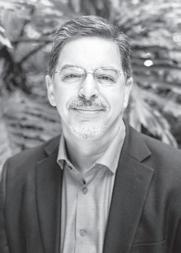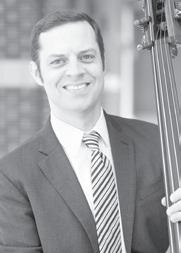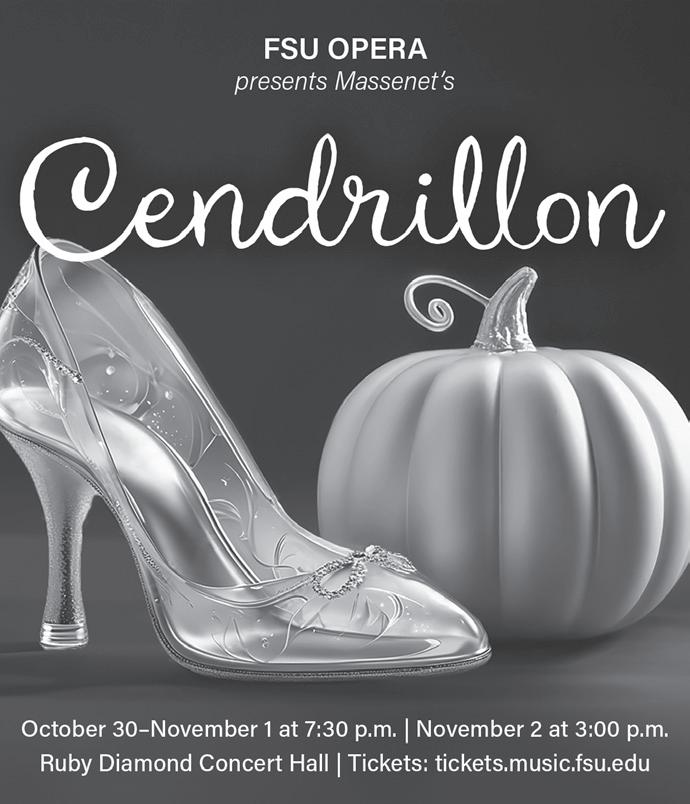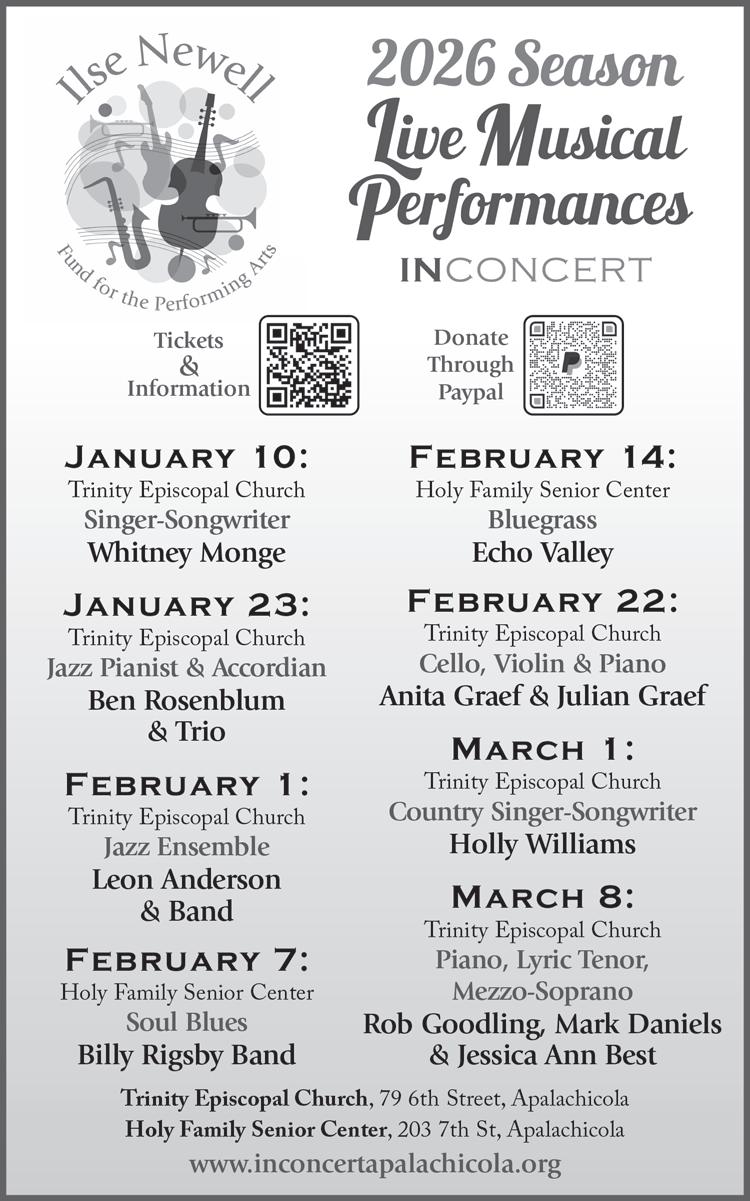ABOUT THE FEATURED SOLOISTS
Associate Professor of Double Bass George Speed enjoys a career that combines teaching with solo, chamber, and orchestral performing. He joins the College of Music faculty after 14 years as Associate Professor of Double Bass at Oklahoma State University, where he received the 2009 Wise-Diggs-Berry Award for Teaching Excellence. For the past four summers, Speed has served on the artist faculty of the Brevard Music Center in Brevard, North Carolina.
Orchestral playing is central to Speed’s career. Recently appointed principal bass with the Tallahassee Symphony, he served as Principal Bass of the Oklahoma City Philharmonic from 2005-2019. For 17 years Speed was a regular player with the Boston Pops Esplanade Orchestra, including numerous television broadcasts and domestic and international tours. He has also performed with the Boston Symphony, Dallas Symphony, Fort Worth Symphony, and Handel and Haydn Society, among others.
Speed is passionate about both chamber music and solo performance. The Pierre Boulez Workshop at Carnegie Hall selected him to perform Schoenberg’s Kammersymphonie, Op. 9 in Weill Recital Hall under Maestro Boulez in 1999. From 2005-2019 he performed regularly with the Oklahoma City-based chamber ensemble Brightmusic. In August 2018, Centaur Records released Speed’s recording of his Vivaldi cello sonata 1-6 transcriptions, with forthcoming print publication by Recital Music.
A native of Spartanburg, South Carolina, Speed earned the Bachelor of Music degree, summa cum laude, from Vanderbilt University, and the Master of Music degree from Boston University. Additional studies include two summers at both the Aspen Music Festival and the Tanglewood Music Center, where he received the Rose Thomas Smith Legacy Prize. His principal teachers were Edwin Barker, Edgar Meyer, and William Scott. Speed plays on a late-19th century Neapolitan bass by Carlo Loveri.

Madison Roths, soprano, is a first year DMA student at Florida State University where she studies with David Okerlund. She is a Kansas native who has been praised for her “wonderful combination of exquisite technique and expression,” and is working actively as a voice teacher, professional choir member, and soloist in Tallahassee. Equally at home in solo or choral repertoire, she was recently seen at FSU as Anne Trulove in Stravinsky’s The Rake’s Progress, as Vixen Bystrouška in Janáček’s The Cunning Little Vixen, and as the soprano soloist with the Festival Singers of Florida singing “Meditations on Death” by Skip Stradtman. Upcoming performances include Fiordiligi in
Mozart’s Così fan tutte with FSU Opera. She has been the recipient of a Graduate Teaching Assistantship from FSU for the 2023-2026 academic years, and works running her private voice studio as well as her alterations business specializing in women’s formal gowns. She also sings on staff at the Co-Cathedral of St. Thomas More. In concert work, Madison has performed as a featured soloist with the Tallahassee Community Chorus, FSU Symphony Orchestra, FSU Chamber Choir, the Festival Singers of Florida, the Wichita Symphony Orchestra, the WSO Chorale, and the Wichita State University Concert Choir and Madrigals. She has received honors as a finalist in the Hannah Beaulieu competition and the WSU Concerto Aria Competition and is a Presser Scholar. In 2025 she and Trevor Landreth formed StaccAria, a percussion and soprano duo that performed the world live premiere of “Annabel Lee” by George Dousis. Since then, the pair have been earnestly working with composers in an effort to expand the repertoire for percussion and voice.
NOTES ON THE PROGRAM
Koussevitsky:
Concerto for Double Bass and Orchestra
Given the abundance of Serge Koussevitzky’s talents (as double bass virtuoso, conductor, publisher, pedagogue, impresario, champion of new music, diplomat), that he was also a composer is often forgotten. True, he did not write a large body of music, and what he wrote was created mostly in his early years for his beloved ugly duckling instrument, the double bass—not usually a glamor instrument but one essential to the functioning of a symphony orchestra. In the first decade of the 20th century, Koussevitzky became a highly successful touring double bass virtuoso, and his primary goal was to expand its limited solo repertoire. Composing also helped him to understand music “from the inside,” a useful skill as he worked to advance his career as a conductor.
Before he left the Russian provinces for the bright lights of Moscow in 1891 at age 17 to make his name in music, Koussevitzky was already an accomplished cellist. When he sought admission to the School of the Moscow Philharmonic Society, he was told he could receive a full scholarship if he chose to study either the trombone or double bass, both shunned by most students. So Koussevitzky happily took up the double bass, which became his ticket into the world of professional music. With the passion and total commitment that he brought to any challenge, he mastered the instrument and used it to rise through the ranks, from first chair double bassist at the Bolshoi Theatre to acclaimed soloist. “An artistic temperament and ambition drove him to it, in order to make this instrument—harsh and primitive according to general opinion—of equal importance with the violin or the cello,” wrote composer Arthur Lourié (1892-1966), Koussevitzky’s friend and biographer.
Lourié also described his style on the instrument. “Koussevitzky’s playing, in comparison with his predecessors’, was modernized; he toned down and really transformed the typical sonority of the orchestral bass, approximating it to that of the cello.” Koussevitzky
often played compositions by the two most famous double-bassists, Italians Domenico Dragonetti (1763-1846) and Giovanni Bottesini (1821-1889), along with arrangements of compositions by Mozart, Handel, and others.
Before completing the concerto, Koussevitzky wrote several salon pieces for solo double bass: Andante, Opus 1; Valse miniature, Opus 2; Chanson triste, Opus 4, and Humoresque. The most ambitious of his compositions, the concerto was planned in 1902 but only finished in 1905. Its completion coincided with his marriage to his second wife, Natalia Konstantinovna Ushkova (1880-1942), daughter of a wealthy tea merchant and philanthropist, to whom the concerto is dedicated. Her enormous fortune gave Koussevitzky complete financial independence and helped him realize his ambitious plans for decades to come. Until Natalia’s death, she and Serge were the center of social life at Tanglewood, where they maintained the gracious hilltop estate they called Seranak, combining their two first names: Serge and Natalie.
In musical style, the concerto draws heavily upon the late romantic legacy of Pyotr Tchaikovsky (1841-1893) and Sergei Rachmaninoff (1873-1943). In three movements in classic fast-slow-fast order, it unfolds quickly and simply, without a pause between the first two movements (Allegro and Andante). Instead of the tuning used for double basses in the orchestra (E-A-D-G), the score specifies that the strings are to be tuned one step higher (so-called “soloist tuning,” F-sharp-B-E-A). In his performances, Koussevitzky used an instrument slightly smaller than the usual orchestral one. His favorite instrument (once thought to have been made by the celebrated 17th-century luthier Nicolò Amati) is played in the July 26, 2024, performance by BSO Principal Double Bass Edwin Barker. This was essentially bequeathed to bassist Gary Karr by Koussevitzky’s third wife, Olga, and passed along by him for use by members of the International Society of Bassists, who have loaned it for the performance.
An opening and insistently repeated six-note motif that stays close to the tonic F-sharp dominates the concerto, reminiscent of Rachmaninoff’s “motto” motifs. The solo part remains mostly in the instrument’s upper register, which projects better and lends itself to more lyrical expression. Following basic sonata form (theme, development, recapitulation), the first movement moves from the rhythmic main theme to a contrasting bel canto (i.e., like an operatic aria) subject, but also gives the soloist ample opportunity to show off with rapid sixteenth-note passages in double stops. The serene second movement develops a song-like pastoral melody that recalls Dvořák’s Cello Concerto (1894) and ends with a passage of glowing harmonic effects. In the energetic finale, Koussevitzky reworks the first movement’s themes, with bravura writing for the soloist.
To some critical ears, Koussevitzky’s musical language was excessively sentimental. Composer Nikolai Medtner (1879-1951) praised his “splendid” performance of the concerto but called the piece itself “dilettantish.” But reviewing the 1905 premiere, Ivan Lipayev praised “the presence of spontaneous feeling and of a temperament which has a particularly contagious quality in the final movement.” When Koussevitzky performed the concerto in a Boston benefit recital (with piano accompaniment) in 1927, the often
harsh Boston Herald critic Philip Hale called it “not a mere show piece for vain display: it is thoughtfully conceived, carefully written, without trivial details.” In 1929, Koussevitzky and pianist Pierre Luboshutz recorded the Andante movement for RCA Victor.
– Harlow Robinson
Mahler: Symphony No. 4 in G Major
Mahler’s Fourth Symphony is the last of the tetralogy known as the “Wunderhorn symphonies” because they used quotes of themes and elements of songs and poems from “Das Knaben Wunderhorn” (The Youth’s Magic Horn). This was an anthology of German folk music and folklore published in 1805 and 1808, which, over many years, captivated Mahler. In the Wunderhorn collection, the title of the poem used in the symphony’s final movement is “There is not a cloud in the sky” but Mahler changed the title in 1892, in his setting, to “Das Himmlische Leben.” Elements from the song appear in the first three movements before it is heard in its entirety in the last movement, sung by soprano. Since this was the composer’s main musical source it is not surprising that he wrote the movements in reverse order, starting with the last, which features the song in its entirety. He began the symphony in 1899 and finished it in 1901.
The music is clearly declaimed throughout and comparatively (for Mahler) lightly scored: no heavy brass (i.e. no trombones or tuba), just horns, trumpets, winds, and reduced strings. The percussion section is interesting: cymbals, sleigh bells, triangle, tam-tam, and glockenspiel along with timpani. The smallness of the orchestra has spawned adaptations for chamber orchestra: for example, by Erwin Stein (Austrian arranger and writer and admirer of Schoenberg) in 1920 and Yoon Jae Lee (2006) in which he further reduced the original score’s string section to single players.
The Fourth Symphony has innocence and congeniality throughout. Each movement is prefaced by instructions that indicate serenity and moderate pace. Many have said it was “accessible, the most accessible of his symphonies to date.” Audiences were a bit perplexed at first, but critics were scathing. A 1904 New York concert described the Fourth as “a drooling and emasculated musical monstrosity.”
This was the first symphony for which the composer did not provide precise programmatic descriptions, preferring that the audience understand music for music, without a specific story at hand. “I know the most wonderful names for the movements, but I will not betray them to the rabble of critics and listeners so that they can subject them to banal misunderstandings and distortions.” At one point he called it a humoresque in six movements.
Eventually, it would be trimmed to four movements, his last symphony without the brooding nature, intensity, size, and vastness of those yet to come. It is the shortest of Mahler’s symphonies, weighing in at just under one hour, and the most frequently
performed. He completed the work August 5, 1900. Mahler seemed happy with it, but nonetheless sent this observation to his wife, Alma. “My Fourth … is all humor, naïve, etc. It is that part of me which is still the hardest for you to accept and which in any case only the fewest of the few will comprehend for the rest of time.”
In The Mahler Companion, Donald Mitchell writes,
The Fourth, to my mind, represents a manifestation of neoclassicism peculiar to Mahler himself, an awareness of and reflection on the role he himself and his work(s) in progress might play in the still evolving history of the idea of the symphony. The Fourth spells out the impossibility of rolling history back or complacently attempting to continue in the line of – wake of, rather – the Great Tradition.
The first movement appears in sonata-allegro format, opening with four flutes and sleigh bells, marked “moderately, not rushed.” This combination will also appear in the fourth movement. The first theme is a friendly melody from the first violins, and the second is a folk-style tune from the celli, marked “sung broadly.” The development reveals more complexity, especially in its contrapuntal textures.
The second movement opens as a delicate scherzo, which includes two trios. Similar to the speed of the first movement: the instruction is “play without haste, leisurely moving.” Mahler’s wife, Alma, noted that his inspiration was a painting (1872) by Arnold Bocklin titled “Self Portrait with death playing the Fiddle.” Mahler described this movement as “Friend Death is Striking up the Dance.” The original title was “Friend Hein Strikes Up.” Hein was a medieval violinist who led his victims to death. Note the solo violin part in which the instrument is tuned higher than usual (scordatura), to give a ghostly atmosphere in his danse macabre. Herein, the violinist is instructed to play “wie ein Fidel” (like a medieval fiddle). To accomplish this, the concertmaster uses two violins. The irony of death and jollity as a combination is cleverly exploited throughout with grim undercurrents from lower instruments. A sudden chirp from the solo violin ends the movement, emerging after a grim section from the lower instruments.
His third movement consists of two contrasting ideas announced at the beginning and set of variations, marked “peacefully, somewhat slowly”. For this, Mahler noted that he had been inspired by church sculptures, which had their arms “closed in eternal peace.”
The last movement — once titled “The Heavenly Life,” is marked “Very comfortably,” featuring a child (represented by the soprano) singing a naïve vision of Heaven and preparation of a feast. The instruction from Mahler is to sing “with child-like, bright expression, and without the slightest suggestion of parody.” The song controls the musical form (strophic) and verses are separated by interludes. The ending is soft, sealed by solo harp repeating alternating fourths, with a final triple pianissimo sustained note from the double basses.
© Marianne Williams Tobias
The
Heavenly Life (from Des Knaben Wunderhorn)
We enjoy heavenly pleasures and therefore avoid earthly ones. No worldly tumult is to be heard in heaven. All live in greatest peace. We lead angelic lives, yet have a merry time of it besides. We dance and we spring, We skip and we sing. Saint Peter in heaven looks on. John lets the lambkin out, and Herod the Butcher lies in wait for it. We lead a patient, an innocent, patient, dear little lamb to its death. Saint Luke slaughters the ox without any thought or concern. Wine doesn’t cost a penny in the heavenly cellars; The angels bake the bread. Good greens of every sort grow in the heavenly vegetable patch, good asparagus, string beans, and whatever we want.
Whole dishfuls are set for us! Good apples, good pears and good grapes, and gardeners who allow everything! If you want roebuck or hare, on the public streets they come running right up. Should a fast day come along, all the fishes at once come swimming with joy. There goes Saint Peter running with his net and his bait to the heavenly pond.
Saint Martha must be the cook. There is just no music on earth that can compare to ours.
Even the eleven thousand virgins venture to dance, and Saint Ursula herself has to laugh. There is just no music on earth that can compare to ours. Cecilia and all her relations make excellent court musicians. The angelic voices gladden our senses, so that all awaken for joy.
University Symphony Orchestra Personnel
Alexander Jiménez, Music Director
Thomas Roggio, Graduate Associate Conductor
Violin 1
Masayoshi Arakawa ‡
Emily Palmer
Stacey Sharpe
Ilayda Ilbas
Keat Zhen Cheong
Francesca Puro
Jean-Luc Cataquet Santaella
Abigail Jennings
Rachel Lawton
Elizabeth Milan
Javaxa Flores
Bailey Bryant
Mari Stanton
Violin 2
Ioana Popescu*
Sobin Son
Alexa Dinges
Victoria Joyce
Will Purser
Carlos Cordero Mendez
Rose Ossi
Christopher Wheaton
Mariana Reyes Parra
Katherine Ng
Amanda Marcy
Quinn French
Noah Johnson
Samuel Ovalle
Viola
Jeremy Hill*
Hannah Jordan
Emelia Ulrich
Abigayle Benoit
Yey Mulero
Harper Knopf
Maya Johnson
Jonathan Taylor
Noel Medford
Tyana McGann
Nathan Oyler
Spencer Schneider
Cello
Thu Vo*
Natalie Taunton
Turner Sperry
Jake Reisinger
Mitchell George
Param Mehta
Abbey Fernandez de Castro
Sydney Spencer
Ryan Wolff
Tia Stajkowski
Jaden Sanzo
Noah Hays
Bass
Caleb Duden*
Josh Dennis
Paris Lallis
Jarobi Watts
Connor Oneacre
Kent Rivera
Flute and Piccolo
Pamela Bereuter*
Samuel Malavé
Kaitlyn Calcagino
Paige Douglas
Oboe
Gracee Myers*
Rebecca Johnson*
Steven Stamer
Rebecca Keith
English Horn
Steven Stamer
Clarinet
Jaxon Stewart*
Anne Glerum*
Hali Alex
Hannah Faircloth
Bass Clarinet
Steven Higbee
Bassoon
Georgia Clement*
Cailin McGarry*
Hannah Farmer
Timothy Schwindt
Contrabassoon
Timothy Schwindt
Horn
Eric On*
Allison Hoffman
Jeason Lopez
Vincent Aldoretta
Trumpet
Noah Solomon*
William Rich
Johniel Nájera
Percussion
Ian Guarraia
Jordan Brown
Matthew Korloch
Miranda Hughes
Timpani
Darci Wright
Harp
Margaret Anne Altagen
Orchestra Manager
Za’Kharia Cox
Orchestra Stage Manager
Carlos Cordero Mendez
Orchestra Librarians
Guilherme Rodrigues
Tom Roggio
Library Bowing Assistant
Victoria Joyce
‡ Concertmaster
* Principal /Co-Principal
2025-2026
Dean’s Circle
Les and Ruth Ruggles Akers
Dr. Pamela T. Brannon
Richard Dusenbury and Kathi Jaschke
CarolAline Flaumenhaft
Joyce Andrews
Louie and Avon Doll
Patrick and Kathy Dunnigan
Kevin and Suzanne Fenton
Andrew and Karen Hoyt
Alexander and Dawn Jiménez
Jim Lee
Paula and Bill Smith
Margaret Van Every
Gold Circle
Albert and Darlene Oosterhof
Bob Parker
Todd and Kelin Queen
Karen and Francis C. Skilling
David and Jane Watson
Bret Whissel
Sustainer
Stan and Tenley Barnes
Kathryn M. Beggs
Karen Bradley
Steve and Pat Brock
Suzi and Scott Brock
Brian Causseaux and David Young
James Clendinen
Mary and Glenn Cole
Carol J. Cooper
Sandy and Jim Dafoe
F. Marshall Deterding and Dr. Kelley Lang
Diane and Jack Dowling
Aaron and Caroline Ellis
John S. and Linda H. Fleming
Joy and James Frank
William Fredrickson and Suzanne Rita Byrnes
Ruth Godfrey-Sigler
Michael and Marsha Hartline
Ken Hays
Melanie Hines and Dudley Witney
Dottie and Jon Hinkle
Todd S. Hinkle
The Jelks Family Foundation, Inc.
Emory and Dorothy Johnson
Gregory and Margo Jones
Anne van Meter and Howard Kessler
Dennis G. King, Esq.
William and Susan Leseman
Annelise Leysieffer
Linda and Bob Lovins
William and Gayle Manley
Robert and Patty McDonald
Marian and Walter Moore
Ann W. Parramore
Almena and Brooks Pettit
David and Joanne Rasmussen
Edward Reid
Mark and Carrie Renwick
Stephen and Elizabeth Richardson
Lawrence and Lisa Rubin
Patrick J. Sheehan
Dr. James and Ruth Anne Stevens
Richard Stevens and Ron Smith
Sustainer cont’d
Marshall and Nell Stranburg
William and Ma’Su Sweeney
Martin Kavka and Tip Tomberlin
Steve Moore Watkins and Karen Sue Brown
Stan Whaley and Brenda McCarthy
Kathy D. Wright
Mary S. Bert
Joe and Susan Berube
Marcia and Carl Bjerregaard
Greg and Karen Boebinger
Larry and Sara Bourdeau
David and Carol Brittain
Dean and Lyndsey Caulkins
Bonnie and Pete Chamlis
Malcolm A. Craig
Linda Davey
Rochelle Davis
Judith Flanigan
Bonnie Fowler, Armor Realty
L. Kathryn Funchess
Harvey and Judy Goldman
Jerry and Bobbi Hill
Sally and Dr. Link Jarrett
Judith H. Jolly
Arline Kern
Jonathan Klepper and Jimmy Cole
Elna Kuhlmann
Keith Ledford
Patron
Donna Legare
Joan Macmillan
Patrick Malone
Victoria Martinez
Stephen Mattingly
Ann and Don Morrow
Joel and Diana Padgett
Karalee Poschman
Mary Anne J. Price
Magda Sanchez
Jill Sandler
Paula S. Saunders
Jeanette Sickel
Susan Sokoll
George Sweat
Ed Valla
Scott and LaDonna Wagers
Sylvia B. Walford
Diana Wang
Geoffrey and Simone Watts
Natalie Zierden
Patricia C. Applegate
Sarah and John Bender
The Boyett Family
Judy and Brian Buckner
Kasia Bugaj and J. Renato Pinto
Robby Bukovic
Darren and Peyton Cassels
Marian Christ
Katie and Daniel Elliott
Sarah Eyerly
Cynthia Foster
Gene and Deborah Glotzbach
Sue Graham
Laura Gayle Green
Miriam Gurniak
Donna H. Heald
Carla Connors and Timothy Hoekman
Jane A. Hudson
Jayme and Tom Ice
Stephanie Iliff
William and DeLaura Jones
Jane Kazmer
Paige McKay Kubik
Joe Lama
Jane LeGette
Eric Lewis
Dr. Lynne Y. Lummel
Cindy Malaway
Lealand and Kathleen McCharen
Dr. Linda Miles
Drs. Linda O’Neil and Sebastian Alston
Becky Parsons
Michelle Peaceman
William and Rebecca Peterson
Adrian and Rachel Puente
Sanford A. Safron
Lori and Charles Smith
Sudarat Songsiridej and Mary Schaad
Susan Stephens
Allison Taylor
C. Richard and Phrieda L. Tuten
Steve Urse
Janie W. Weis
Karen Wensing
Lifetime Members
Willa Almlof
Florence Helen Ashby
Mrs. Reubin Askew
Tom and Cathy Bishop
Nancy Bivins
Ramona D. Bowman
André and Eleanor Connan
Russell and Janis Courson
J.W. Richard Davis
Ginny Densmore
Carole Fiore
Patricia J. Flowers
Hilda Hunter
Julio Jiménez
Kirby W. and Margaret-Ray Kemper
Patsy Kickliter
Anthony M. Komlyn
Fred Kreimer
Beverly Locke-Ewald
Cliff and Mary Madsen
Ralph and Sue Mancuso
Meredith and Elsa L. McKinney
Ermine M. Owenby
Mike and Judy Pate
Laura and Sam Rogers
Dr. Louis St. Petery
Sharon Stone
Donna C. Tharpe
Brig. Gen. and Mrs. William B. Webb
Rick and Joan West
John L. and Linda M. Williams
Sallie and Duby Ausley
Beethoven & Company
Corporate Sponsors
Ron Erichson/Beth Frederick
Business Sponsors
WFSU Public Broadcast Center
The University Musical Associates is the community support organization for the FSU College of Music. The primary purposes of the group are to develop audiences for College of Music performances, to assist outstanding students in enriching their musical education and careers, and to support quality education and cultural activities for the Tallahassee community. If you would like information about joining the University Musical Associates, please contact Kim Shively, Director of Special Programs, at kshively@fsu.edu or 850-645-5453.
The Florida State University provides accommodations for persons with disabilities. Please notify the College of Music at 850-644-3424 at least five business days prior to a musical event if accommodation for disability or publication in alternative format is needed.












